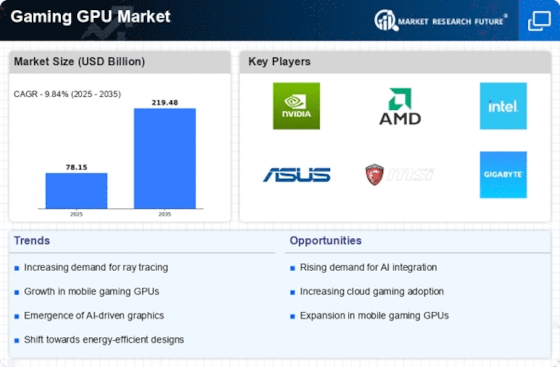Emergence of Mobile Gaming
The emergence of mobile gaming has introduced a new dynamic to the Gaming GPU Market. As smartphones and tablets become increasingly powerful, they are capable of delivering gaming experiences that rival traditional consoles and PCs. This shift has prompted GPU manufacturers to innovate and create mobile-specific graphics solutions that provide high performance in compact form factors. The mobile gaming market is projected to grow at a rapid pace, with millions of users opting for gaming on-the-go. This trend not only expands the consumer base for gaming GPUs but also encourages manufacturers to diversify their product offerings. As a result, the Gaming GPU Market is likely to see a rise in demand for GPUs that cater to mobile gaming, further driving market growth.
Advancements in Graphics Technology
Technological advancements play a pivotal role in shaping the Gaming GPU Market. Innovations such as ray tracing, machine learning, and real-time rendering are revolutionizing the gaming experience, allowing for more realistic graphics and immersive environments. The introduction of new architectures and manufacturing processes has led to GPUs that are not only more powerful but also more energy-efficient. For instance, the latest GPU models are designed to deliver superior performance while consuming less power, addressing the growing concern for energy efficiency among consumers. This trend is expected to continue, with research indicating that the market for advanced graphics technologies will expand significantly, further driving the demand for high-performance GPUs in the gaming sector.
Increasing Demand for High-Performance Gaming
The Gaming GPU Market experiences a surge in demand for high-performance graphics processing units as gamers seek enhanced visual experiences and smoother gameplay. The rise in competitive gaming and eSports has further fueled this demand, with players requiring GPUs that can handle intensive graphics and high frame rates. According to recent data, the market for gaming GPUs is projected to grow at a compound annual growth rate of approximately 10% over the next few years. This growth is driven by the increasing popularity of 4K gaming and virtual reality applications, which necessitate advanced GPU capabilities. As a result, manufacturers are focusing on developing cutting-edge technologies to meet the evolving needs of gamers, thereby propelling the Gaming GPU Market forward.
Growth of Online Gaming and Streaming Services
The proliferation of online gaming and streaming services has a profound impact on the Gaming GPU Market. As more players engage in multiplayer online games and utilize platforms for streaming gameplay, the need for robust GPUs becomes increasingly critical. The rise of services such as Twitch and YouTube Gaming has created a new generation of content creators who rely on high-quality graphics to attract viewers. Market analysis suggests that the online gaming sector is expected to grow substantially, with millions of new users joining each year. This growth directly correlates with the demand for advanced gaming GPUs, as users seek to enhance their gaming and streaming experiences. Consequently, manufacturers are likely to invest in developing GPUs that cater specifically to the needs of online gamers and streamers.
Rising Popularity of Virtual Reality and Augmented Reality
The rising popularity of virtual reality (VR) and augmented reality (AR) applications is significantly influencing the Gaming GPU Market. As these technologies become more mainstream, the demand for GPUs capable of rendering complex 3D environments in real-time is increasing. VR and AR require high-performance graphics to deliver immersive experiences, which in turn drives the need for advanced GPUs. Market forecasts indicate that the VR and AR sectors are expected to grow exponentially, leading to a corresponding rise in demand for specialized gaming GPUs. Manufacturers are responding by developing GPUs that are optimized for VR and AR applications, ensuring that they meet the stringent performance requirements of these technologies. This trend is likely to propel the Gaming GPU Market into new heights.

















Leave a Comment